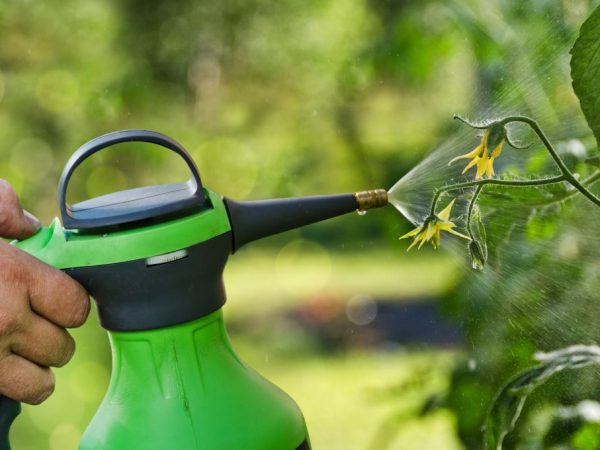The benefits of feeding tomatoes with hydrogen peroxide
Tomatoes culture is demanding for care and nutrition. Without top dressing, you can hardly get a good result. For several years now, fertilizing tomatoes with hydrogen peroxide has helped gardeners grow healthy plants. The drug plays the role of fertilizer, growth stimulant and prophylactic agent against diseases, and also protects bushes from pests.

The benefits of feeding tomatoes with hydrogen peroxide
Benefits of hydrogen peroxide
Hydrogen peroxide (peroxide) H2O2 is a transparent, odorless substance that has antiseptic and disinfecting properties. Among the useful properties of this substance, it is worth highlighting:
- disinfects plant damage sites;
- enriches the root system with oxygen;
- increases seed germination;
- helps to absorb trace elements;
- improves soil structure;
- neutralizes nitrates, chlorine and nitrites;
- renews manganese and iron salts.
Atomic oxygen contained in hydrogen peroxide is easily detached from the molecule, enriching the soil and plants with oxygen. This stimulates metabolic processes, and nutrients are supplied to the plant more intensively.
This substance is characterized by a redox reaction, which plays an important role. It is capable of oxidizing (neutralizing) nitrites and nitrates. Improves the quality of water for irrigation by oxidizing chlorine and disinfecting it. And also, getting into the soil, it restores the salts of manganese and iron, which are needed by tomatoes for full development.
Seed treatment and seedling fertilization
The substance can be used as a dressing agent at the stage of sowing seeds. And also as fertilizer for seedlings.
The soil is treated with peroxide for disinfection, and the seeds are soaked to disinfect and stimulate growth. For this purpose, a 1% solution is prepared (10 ml of peroxide per 1 liter of water), the seeds are kept in it for 20-30 minutes. Thoroughly spill the soil with such a solution. Many vegetable growers confirm the effectiveness of the drug for improving the germination of seeds.
Such fertilization is irreplaceable during the period of growing seedlings. To feed the seedlings, prepare a solution and 0.5 tbsp. l. peroxide is added to 1 liter of settled water. Once a week, ordinary water for irrigation is replaced with a solution and young plants are well watered. The first such feeding is carried out no earlier than 2-3 weeks after germination.
Top dressing of adult bushes

It is important to prepare the solution correctly
After planting tomatoes in the ground, they will need repeated replenishment with nutrients. In parallel with the introduction of various fertilizers, peroxide feeding is carried out.
To fertilize tomatoes, use a preparation in the form of a solution, which is watered under a bush. To prepare a solution, 50 ml of peroxide is dissolved in 10 liters of water. This feeding is carried out once every 7-10 days.
Foliar top dressing can also be carried out by spraying the bushes with a weak solution. It is important to observe dosing for spraying, add 10 tbsp to 10 liters of water. l. peroxide. Spraying is carried out in the evening.This will help saturate the sheets with oxygen, which is necessary for the dissimilation (combustion) process. By burning oxygen and glucose, the plant receives the energy necessary for growth.
Prevention of fungal diseases
Peroxide shows good results as a prophylactic agent against fungal diseases. The drug will not be able to cure diseased tomatoes, but it will prevent their infection. Hydrogen peroxide is used to prevent:
- late blight;
- root rot;
- white spot.
The causative agents of these diseases are fungal pathogenic bacteria, they are referred to as aerobic microorganisms. The atomic, active oxygen contained in hydrogen peroxide has a toxic effect on such bacteria. It disrupts the processes of their vital activity and stops development.
For preventive purposes, a solution is used with which tomatoes are sprayed against late blight and white spot, plants are watered under the root from root rot. To prepare a properly concentrated solution, take 10 ml of peroxide (3%) and dilute with 1 liter of water. Spraying and watering can be alternated; such treatments are carried out twice a week.
Pest control
Peroxide is also used to combat tomato pests (aphids, scoops, whiteflies). According to observations, the drug copes well with them and does not harm tomatoes.
If pests are found, use a solution for which you will need;
- 1 tbsp. l. hydrogen peroxide;
- 10 ml of ammonia;
- 1 tbsp. l. crushed laundry soap;
- 1 liter of warm water.
All ingredients are thoroughly mixed and the bushes are sprayed with a freshly prepared solution. Repeat the treatment after 10 days.
Conclusion
Peroxide is a universal remedy that has proven itself not only in medicine, but also in horticulture. The use of peroxide brings a positive result when growing tomatoes in a personal plot. Compliance with the norms will allow you to grow healthy plants without resorting to chemical fertilizers.


